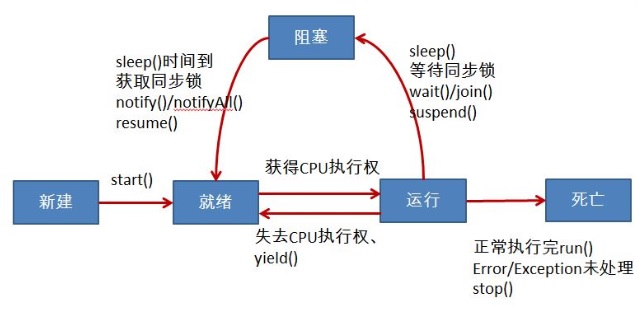一、线程的特点
1.线程的分类
java中的线程分为两类:守护线程和用户线程。唯一的区别是判断JVM何时离开。
守护线程是用来服务用户线程的,通过在start()方法前调用Thread.setDaemon(true)可以把一个用户线程变成一个守护线程。
java垃圾回收就是一个典型的守护线程;若JVM中都是守护线程,当前JVM将退出。
2.线程的生命周期

3.线程的同步机制
(1)线程的安全问题
在上一篇随笔中,多窗口售票的程序代码存在线程的安全问题,打印车票会出现重票、错票。
安全问题存在的原因:
由于一个线程在操作共享数据时,未执行完毕的情况下就有另外的线程参与进来,导致共享数据存在了安全问题。
解决方法:
让一个线程操作共享数据完毕后,其他线程才有机会参与共享数据的操作,即采用同步机制。
(2)方法一:同步代码块
synchronized(同步监视器){
//需要被同步的代码块(即为操作共享数据的代码)
}
同步监视器:由任意一个类的对象来充当,哪个线程获取此监视器,谁就执行大括号里被同步的代码,俗称:锁。
要求:
所有线程必须共用同一把锁。
在实现的方式中可以用this来当同步锁,在继承的方式中慎用this,因为this将指向不同的对象。
多窗口售票代码案例
class Window implements Runnable{
int ticket = 100;//共享数据
Object obj = new Object();//创建一个对象,作为同步锁。
public void run(){
//Object obj = new Object();注意不能在这里创建,局部变量起不到同步控制的作用。
while(true){
synchronized(obj){//同步控制,obj作为锁,也可以用this
if(ticket > 0){
System.out.println(Thread.currentThread().getName()+"售票,票号为:" + ticket--);
}else{
break;
}
}
}
}
}
(3)方法二:同步方法
将操作共享数据的方法声明为synchronized,能够保证当一个线程执行此方法时,其他线程在外等待直至此线程执行完此方法。
同步锁:this(即调用该方法的对象,所以只适用实现的多线程方法,不适用于继承的多线程方法)
多窗口售票代码案例
class Window implements Runnable{
int ticket = 100;//共享数据
public void run(){
while(true) {
show();
}
}
public synchronized void show() {
if (ticket > 0) {
try {
Thread.currentThread().sleep(10);
} catch (InterruptedException e) {
e.printStackTrace();
}
System.out.println(Thread.currentThread().getName() + "售票,票号为:" + ticket--);
}
}
}
(4)单例模式懒汉式的线程安全问题:使用同步机制
注意:对于一般的方法可以使用this当同步锁;但对于静态方法就没办法使用this,而是使用当前类本身充当锁。
public class Singleton {
private Singleton(){
}
private static Singleton instance = null;
public static Singleton getInstance() {
synchronized (Singleton.class) {//注意静态方法的同步锁使用类本身
if (instance == null) {
instance = new Singleton();
}
}
return instance;
}
}
(5)释放同步锁的操作:
同步代码块、同步方法中执行了线程对象的wait()方法,当前线程暂停,并释放锁。
(6)不释放锁的操作:
Thread.sleep()、Thread.yield()暂停当前线程的执行,但不会释放锁。
(7)线程同步练习
有两个储户分别向同一个账户存3000元,每次存1000元,每次存完打印账户余额。(存在线程安全问题)
class Account{
double balance;
public Account() {
}
//存钱
public synchronized void deposit(double amt) {
balance += amt;
try {
Thread.currentThread().sleep(100);//为了让错误暴露出来
} catch (InterruptedException e) {
e.printStackTrace();
}
System.out.println(Thread.currentThread().getName()+":"+balance);
}
}
class Customer extends Thread{
Account account;
public Customer(Account account) {
this.account = account;
}
@Override
public void run() {
for(int i = 0;i < 3; i++) {
account.deposit(1000);
}
}
}
public class Test{
public static void main(String[] args) {
Account a = new Account();
Customer c1 = new Customer(a);
Customer c2 = new Customer(a);
c1.setName("甲");
c2.setName("乙");
c1.start();
c2.start();
}
}
(8)死锁的问题
不同的线程分别占用对方需要的同步资源不放弃,都在等待对方放弃自己需要的资源,就形成了死锁。
代码案例:
public class Test{
//两个同步资源
static StringBuffer sb1 = new StringBuffer();
static StringBuffer sb2 = new StringBuffer();
public static void main(String[] args) {
new Thread(){
public void run(){
synchronized(sb1){//得到同步锁sb1
try{
Thread.currentThread().sleep(10);//通过sleep将问题暴露出来
}catch(InterruptedException e){
e.printStackTrace();
}
sb1.append("A");
synchronized(sb2){//得不到同步锁sb2
sb2.append("B");
System.out.println(sb1);
System.out.println(sb2);
}
}
}
}.start();
new Thread(){
public void run(){
synchronized(sb2){//得到同步锁sb2
try{
Thread.currentThread().sleep(10);
}catch(InterruptedException e){
e.printStackTrace();
}
sb1.append("C");
synchronized(sb1){//得不到同步锁sb1
sb2.append("D");
System.out.println(sb1);
System.out.println(sb2);
}
}
}
}.start();
}
}
(9)线程的通信
wait():令当前线程挂起并放弃CPU、同步资源,排队等候再次对资源的访问。
notify() / notifyAll():唤醒一个或所有正在排队等候同步资源的线程,一个是指优先级最高的线程。
java.lang.Object提供的这三个方法只有在synchronized代码块或synchronized方法中才能使用,否则报异常。
代码案例:
使用两个线程交替打印1-100。
class PrintNum implements Runnable{
int num = 1;
public void run(){
while(true){
synchronized(this){
notify();//唤醒另一个线程,等待p的获得
if(num <= 100){
System.out.println(Thread.currentThread().getName()+num);
num++;
}else{
break;
}
try{
wait();//挂起,释放p
}catch(InterruptedException e){
e.printStackTrace();
}
}
}
}
}
public class Test{
public static void main(String[] args) {
PrintNum p = new PrintNum();
Thread t1 = new Thread(p);
Thread t2 = new Thread(p);
t1.setName("甲");
t2.setName("乙");
t1.start();
t2.start();
}
}
(10)生产者消费者问题
生产者(producer)将产品交给店员(Clerk),由消费者(Customer)从店员取走商品。店员最多只能保存20件商品,如果生产者试图生产更多商品,店员会通知生产者停止生产,店中有空位放产品再通知生产者开始生产;如果店中没有产品,店员通知消费者等一下,有产品再通知消费者取走产品。
class Clerk{
int product = 0;
public synchronized void addProduct(){
if(product < 20){
product++;
System.out.println(Thread.currentThread().getName()+"生产了第"+product+"件产品");
notifyAll();
}else{
try{
wait();
}catch(InterruptedException e){
e.printStackTrace();
}
}
}
public synchronized void consumeProduct(){
if(product > 0){
product--;
System.out.println(Thread.currentThread().getName()+"消费了第"+product+"件产品");
notifyAll();
}else{
try{
wait();
}catch(InterruptedException e){
e.printStackTrace();
}
}
}
}
class Producer implements Runnable{
Clerk clerk = null;
public Producer(Clerk clerk){
this.clerk = clerk;
}
public void run(){
System.out.println("生产者开始生产产品");
while(true){
try{
Thread.currentThread().sleep(100);
}catch(InterruptedException e){
e.printStackTrace();
}
clerk.addProduct();
}
}
}
class Customer implements Runnable{
Clerk clerk = null;
public Customer(Clerk clerk){
this.clerk = clerk;
}
public void run(){
System.out.println("消费者开始消费产品");
while(true){
try{
Thread.currentThread().sleep(300);
}catch(InterruptedException e){
e.printStackTrace();
}
clerk.consumeProduct();
}
}
}
public class Test{
public static void main(String[] args){
Clerk c = new Clerk();
Producer p1 = new Producer(c);
Customer c1 = new Customer(c);
Thread t1 = new Thread(p1);
Thread t2 = new Thread(p1);
Thread t3 = new Thread(c1);
t1.setName("生产者1号");
t2.setName("生产者2号");
t3.setName("消费者1号");
t1.start();
t2.start();
t3.start();
}
}



